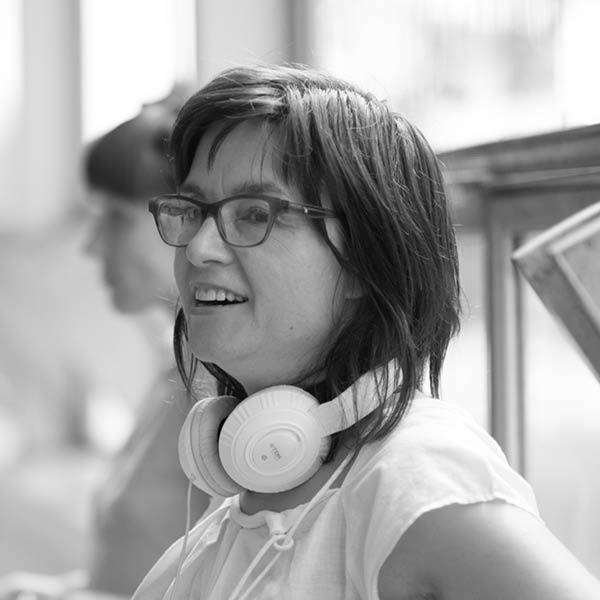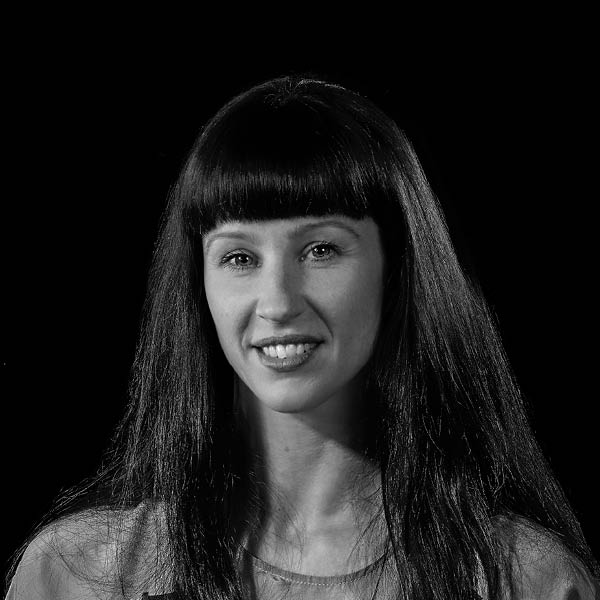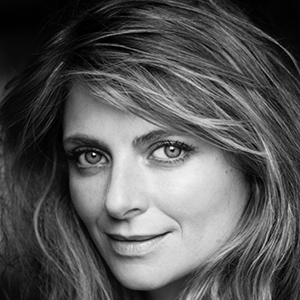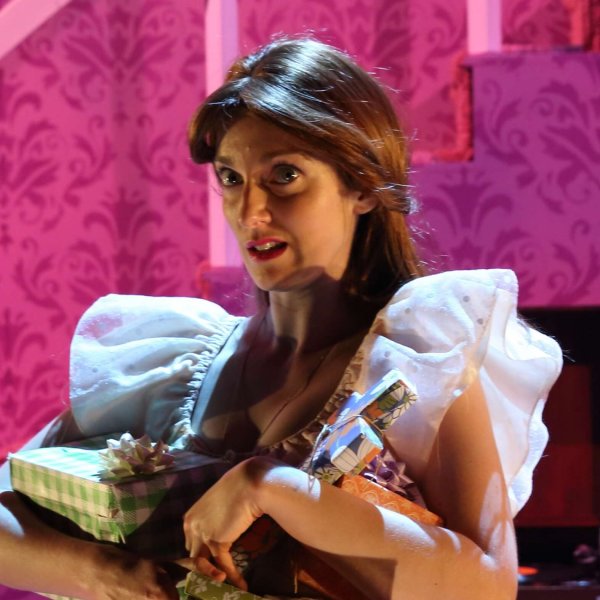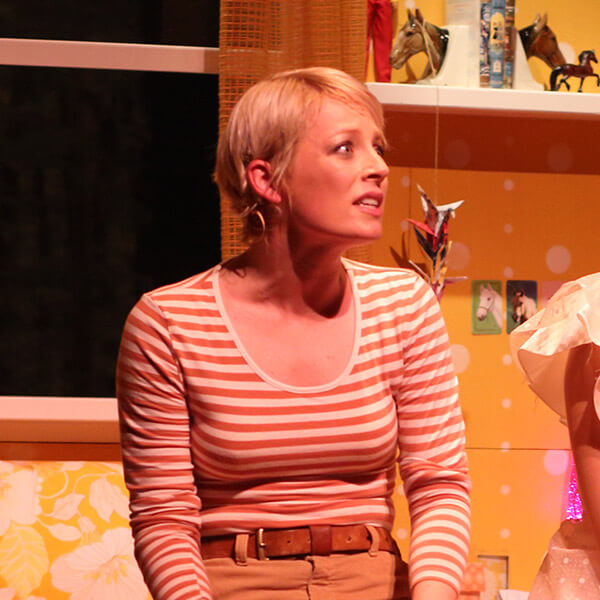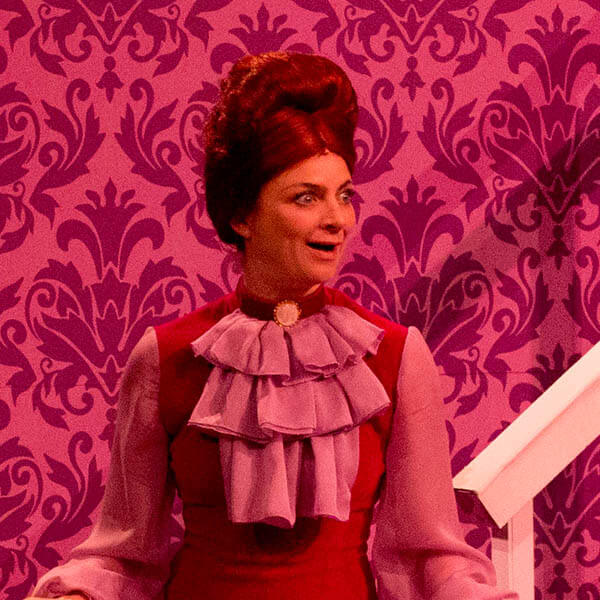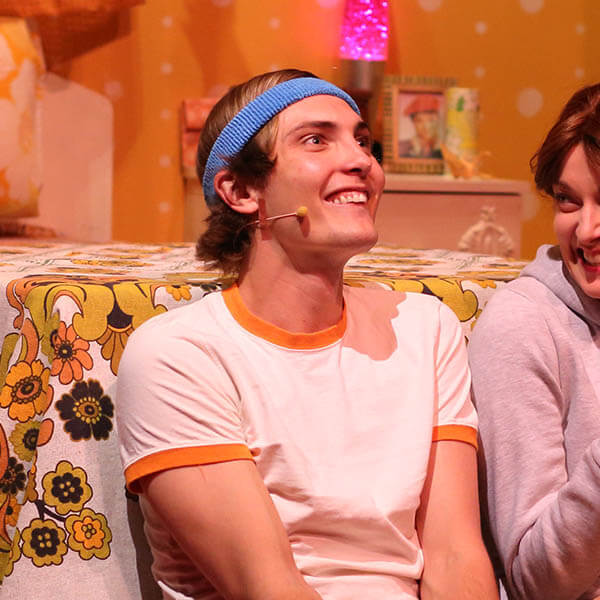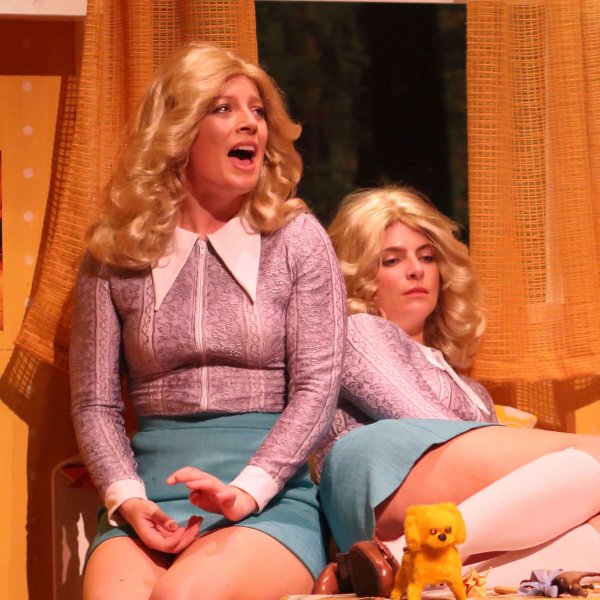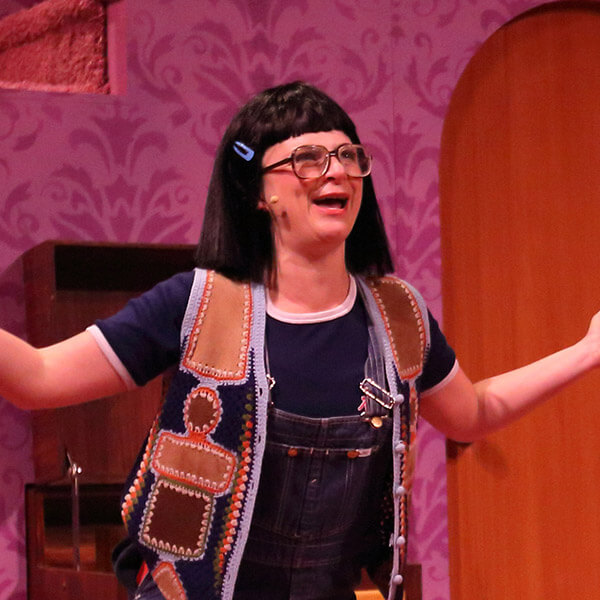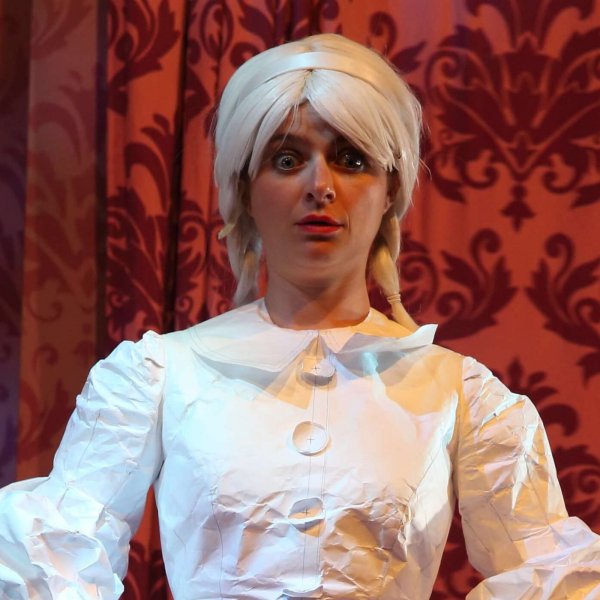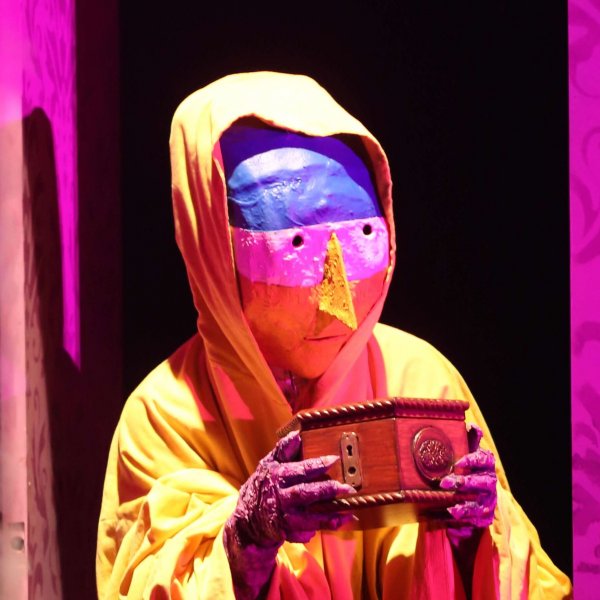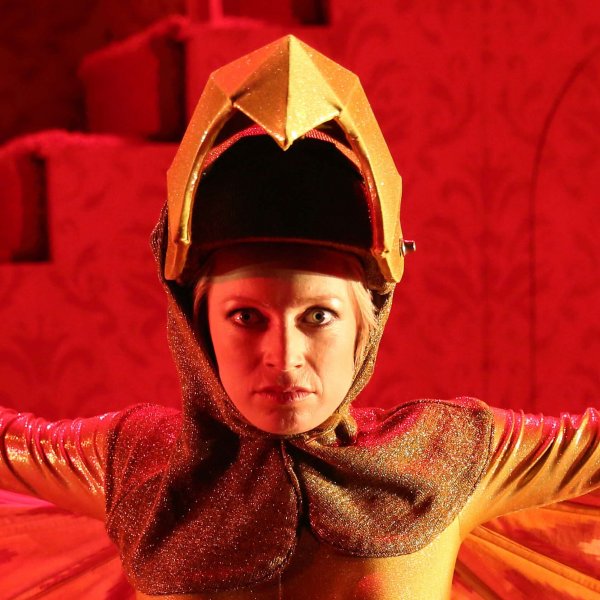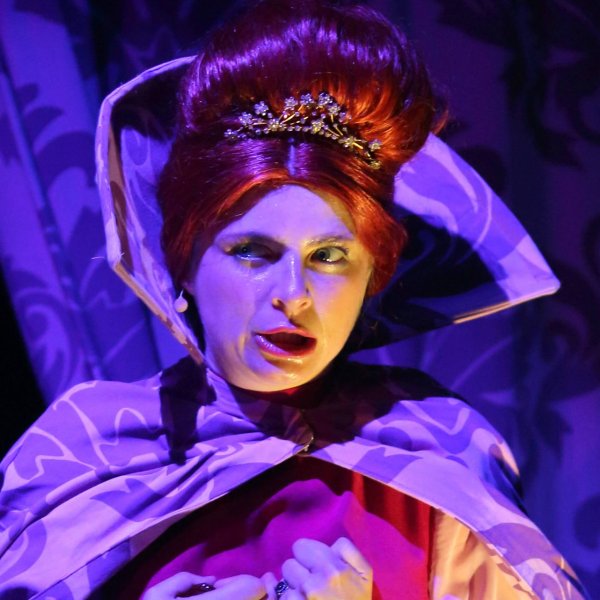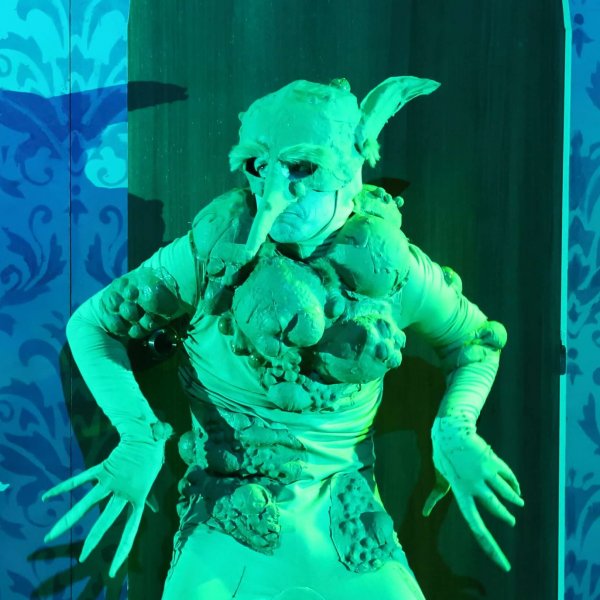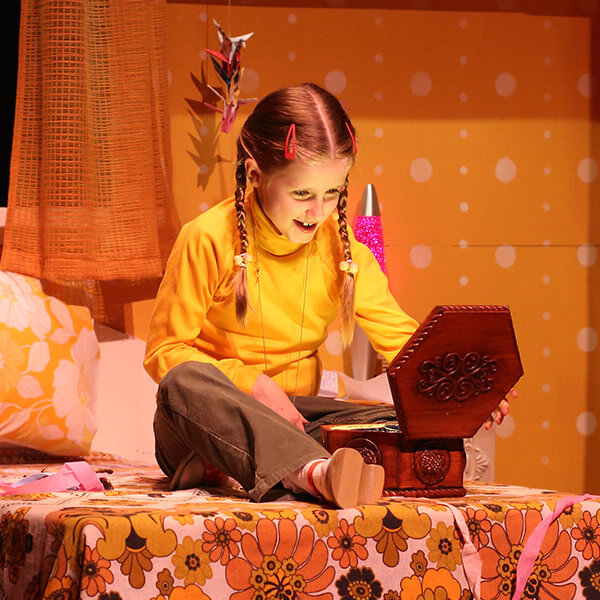Prepare
ACHIEVEMENT STANDARDS ADDRESSED
Receptive modes (listening, reading and viewing)
By the end of Year 8, students identify and analyse how the elements of drama are used, combined and manipulated in different styles. They apply this knowledge in drama they make and perform. They evaluate how they and others from different cultures, times and places communicate meaning and intent through drama.
Students collaborate to devise, interpret and perform drama. They manipulate the elements of drama, narrative and structure to control and communicate meaning. They apply different performance styles and conventions to convey status, relationships and intentions. They use performance skills and design elements to shape and focus theatrical effect for an audience.
Year 7 and 8 Drama content descriptions addressed
Combine the elements of drama in devised and scripted drama to explore and develop issues, ideas and themes (ACADRM040)
Develop roles and characters consistent with situation, dramatic forms and performance styles to convey status, relationships and intentions (ACADRM041)
Plan, structure and rehearse drama, exploring ways to communicate and refine dramatic meaning for theatrical effect (ACADRM042)
Develop and refine expressive skills in voice and movement to communicate ideas and dramatic action in different performance styles and conventions, including contemporary Australian drama styles developed by Aboriginal and Torres Strait Islander dramatists (ACADRM043)
Perform devised and scripted drama maintaining commitment to role (ACADRM044)
Analyse how the elements of drama have been combined in devised and scripted drama to convey different forms, performance styles and dramatic meaning (ACADRR045)
Identify and connect specific features and purposes of drama from contemporary and past times to explore viewpoints and enrich their drama making, starting with drama in Australia and including drama of Aboriginal and Torres Strait Islander Peoples (ACADRR046)
Before Viewing the Play
ACTIVITY
This unit includes activities and assessment linked to The Arts: Drama, Australian Curriculum across Years 7 and 8. Teachers can choose to use individual activities to complement existing drama units or complete the entire unit of work with their students.
The learning activities can provide a structure to view and explore Amphibian with your students. They will provide opportunity for students to explore the play resources independently as well as generate class discussion and sharing of interpretations of the play.
Tune-in
‘Family’ is an important theme in ‘Girl Asleep’ (see themes section of this resource). In groups of five students create freeze frames of family photographs that capture families who:
- have dreams of being on a television competitive cooking show;
- love online gaming;
- enjoy kite flying and picnics on the weekends;
- are super sporty and incredibly competitive;
- collect unusual pets.
Ensure everyone in the group has a particular role, student know where the ‘camera’ is placed for the photo and the relationships between family members is clear. Use the Elements of Drama, movement (including facial expression), space (between characters; levels), status and tension to convey dramatic meaning.
Show work to class and ask audience to provide feedback to the group about roles they saw portrayed and how the family’s interests were conveyed via the Elements of Drama.
As a class students read the character descriptions of the Driscoll family members, Greta, Janet, Conrad and Genevieve. In groups of four create two Driscoll family photos – when Greta was eight and just before Greta turns 15. How are they different and how are they the same and why?
Show to class.
Create
Greta’s bedroom is her safe haven. It is a place where she keeps her previous childhood memories including: the music box her mum, Janet, gave her on her eighth birthday; her letters from her pen pal also named Greta; and her plastic horse collection. These memories are mixed with treasures of her life now as a teenager.
Students read Jonathon Oxlade’s approach to designing the set and costume for ‘Girl Asleep’. In his design of Greta’s bedroom, he conveys her personality and what is precious to her.
In role as set designer, design the set of your own bedroom. Students are to consider:
- What would you include and highlight to convey your personality and what you treasured from different times in your life?
- How would you convey to the audience your moving from childhood to adolescence?
- The use of the following design elements in your design:
- colour;
- pattern;
- space;
- props and larger set pieces.
Critique:
To accompany their set design from the ‘Create’ pre-show section of this resource, students complete the following to explain their design.
- Identify two of the following design elements you used in the set design of your bedroom:
- colour;
- pattern;
- space;
- props and larger set pieces.
- Describe why and how you used these design elements in your set design to convey to the audience your personality and what you held precious.
Students share their designs and explanations in small groups and then exhibit them in the classroom.
Explore and Apply
Place around the room objects that students may be familiar with that could also be considered symbolic of something. For example, a key – open a door to a new journey; a matchbox car – memories of childhood; mirror – looking for your identity.
Choose a variety of emotive music (for example: soundtracks; lullabies) to play as students silently move through the space with paper and pen, responding to the symbols and writing what they think the object could symbolise to them. As the music changes, invite students to revisit some of the symbols to see if the meaning of the object changes for them.
Students sit in groups of four with their responses. Teacher asks students to share with their group their responses to the symbols.
Ask students what does ‘symbol’ mean? Can they be interpreted differently for people? How can the Element of Drama, symbol, be used in the theatre to convey a deeper meaning to an audience? Can any students share other symbols they have seen in their lives and what they meant to them?
There are many symbols in ‘Girl Asleep’ that heighten the dramatic meaning being played on stage. Look out for them throughout the play and see if you can identify at least two and explain to your class after you see they show why they were used and what layered meaning they added.
LEARNING OUTCOMES
Combine the elements of drama in devised and scripted drama to explore and develop issues, ideas and themes (ACADRM040)
Develop roles and characters consistent with situation, dramatic forms and performance styles to convey status, relationships and intentions (ACADRM041)
Plan, structure and rehearse drama, exploring ways to communicate and refine dramatic meaning for theatrical effect (ACADRM042)
Develop and refine expressive skills in voice and movement to communicate ideas and dramatic action in different performance styles and conventions, including contemporary Australian drama styles developed by Aboriginal and Torres Strait Islander dramatists (ACADRM043)
Perform devised and scripted drama maintaining commitment to role (ACADRM044)
Analyse how the elements of drama have been combined in devised and scripted drama to convey different forms, performance styles and dramatic meaning (ACADRR045)
After Viewing the Play
Tune-in
Denise Mackall has an obsessive crush on Elliott. Students brainstorm their memories of Denise from the performance.
It is Valentine’s Day and in role as Denise students each create a Valentine’s Day card for Elliott that Denise will present to him at lunch time*. In the card, students will write an original verse that expresses Denise’s love for her ‘dreamboat’.
With their cards, students walk through the space as if they are walking with a friend across the school quadrangle or playground. Teacher carries a pair of crazy glasses and hands these to a student who immediately puts them on and adopts the role of Denise (teacher encourages students to encapsulate Denise’s energy) and finds her ‘Elliott’. All other students stop walking and focus on Denise and the scene ensuing. Denise reads Elliott the verse and presents the card to Elliott who accepts it accordingly. Students clap performance as it will be exaggerated and hopefully highly entertaining! Students return glasses to teacher; playground returns to normal until the next student is chosen. Students display their cards in the classroom.
*If required, students can change the name of Denise to Denis and Elliott to Ella. Instead of presenting to a student, students can present their card to an effigy of the receiving character.
Create
Read ‘Rites of Passage’ from the theme section of this resource. Cultures all over the world have rites of passage that celebrate a child’s transition to teenage years. Ask students:
- What is a rite of passage? What might you expect to see in such a celebration? For example, music, dress/costume, roles, symbols including colour and objects, movement and language.
- Does anyone in their family/culture celebrate a rite of passage? Explain to the class what is involved.
- Does anyone know of any other cultures that celebrate a rite of passage? Students have the option research online to find examples of rites of passage to gain a fuller understanding and see visual examples. Students share their findings with a partner or with the class.
- Why would cultures or families think it is important to celebrate this time in someone’s life?
- In groups of four or five, students devise a rite of passage ritual of one to two minutes for contemporary teenagers. Consider the inclusion of the following Elements of Drama:
- Symbol (including dress/costume, colour and props)
- Mood (for example, use of music)
- Space
- Roles
- Movement
- Language
- Students present their work to the class. Audience provides feedback on moments from the performance that had a significant impact on them.
Critique
Responding to live theatre helps students become better dramatic artists. Students engage with the Study Guides’ ‘Responding to Drama’ resource.
Students choose one of the performances (other than their own) from the ‘Create’ post-show learning experiences and write a response to the following:
- Explain what you think the group was intending to convey to the audience about transitioning from childhood to adolescence.
- Identify two Elements of Drama that were evident in the performance:
- Symbol (including dress/costume, colour and props)
- Mood (for example, use of music)
- Space
- Roles
- Movement
- Language
- Explain how these chosen Elements of Drama were used to communicate to the audience the group’s intended meaning about transitioning from childhood to adolescence.
- Evaluate how effectively these chosen Elements of Drama were used to convey this meaning to the audience and the overall impact the performance had on you.
Students share their responses with a partner.
Explore and Apply
Students revisit their understanding of the Elements of Drama, symbol from the pre-show ‘Explore and Apply’ learning experiences. Students share as a class, two symbols they identified in the play and explain their meaning.
When Greta fell asleep and visited the ‘other realm’ she met characters that were very strange but somehow were also familiar to her. Symbol was used to create these abstract characters and their costumes. Ask students to identify the characters Greta met. For example:
- Pen pal, Greta
- Goblin
- Queen
- Firebird
- Horse
- Dogs
Divide the class into even groups and assign them each a character (other than Greta). Students sit in a circle each with a pen. Place a large piece of butcher’s paper in the centre of the circle and ask one student to write their assigned character’s name in the centre of the paper. Students brainstorm their responses on the paper to the following questions:
- Describe the character’s personality.
- How does the character’s movement and voice reflect this personality?
- How does costume designer, Johnathon Oxlade, symbolise the character’s personality in his design of their costume including colour, texture and fabric choice?
- What connection and relationship does the character have to Greta? How is this reflected in the costume design?
Students move through the space reading other groups’ responses. Drawing on these ideas students, individually choose one of the characters and create their own costume design. Students share and explain their designs in small groups and display them in the classroom.
LEARNING OUTCOMES
Combine the elements of drama in devised and scripted drama to explore and develop issues, ideas and themes (ACADRM040)
Develop roles and characters consistent with situation, dramatic forms and performance styles to convey status, relationships and intentions (ACADRM041)
Plan, structure and rehearse drama, exploring ways to communicate and refine dramatic meaning for theatrical effect (ACADRM042)
Develop and refine expressive skills in voice and movement to communicate ideas and dramatic action in different performance styles and conventions, including contemporary Australian drama styles developed by Aboriginal and Torres Strait Islander dramatists (ACADRM043)
Perform devised and scripted drama maintaining commitment to role (ACADRM044)
Analyse how the elements of drama have been combined in devised and scripted drama to convey different forms, performance styles and dramatic meaning (ACADRR045)
Identify and connect specific features and purposes of drama from contemporary and past times to explore viewpoints and enrich their drama making, starting with drama in Australia and including drama of Aboriginal and Torres Strait Islander Peoples (ACADRR046)
Prepare
YEAR 9 AND 10 ACHIEVEMENT STANDARD ADDRESSED
Receptive modes (listening, reading and viewing)
By the end of Year 10, students analyse the elements of drama, forms and performance styles and evaluate meaning and aesthetic effect in drama they devise, interpret, perform and view. They use their experiences of drama practices from different cultures, places and times to evaluate drama from different viewpoints.
Students develop and sustain different roles and characters for given circumstances and intentions. They perform devised and scripted drama in different forms, styles and performance spaces. They collaborate with others to plan, direct, produce, rehearse and refine performances. They select and use the elements of drama, narrative and structure in directing and acting to engage audiences. They refine performance and expressive skills in voice and movement to convey dramatic action.
Year 9 and 10 Drama content descriptions addressed
Improvise with the elements of drama and narrative structure to develop ideas, and explore subtext to shape devised and scripted drama (ACADRM047)
Manipulate combinations of the elements of drama to develop and convey the physical and psychological aspects of roles and characters consistent with intentions in dramatic forms and performance styles (ACADRM048)
Practise and refine the expressive capacity of voice and movement to communicate ideas and dramatic action in a range of forms, styles and performance spaces, including exploration of those developed by Aboriginal and Torres Strait Islander dramatists (ACADRM049)
Structure drama to engage an audience through manipulation of dramatic action, forms and performance styles and by using design elements (ACADRM050)
Perform devised and scripted drama making deliberate artistic choices and shaping design elements to unify dramatic meaning for an audience (ACADRM051)
Evaluate how the elements of drama, forms and performance styles in devised and scripted drama convey meaning and aesthetic effect (ACADRR052)
Before Viewing the Play
ACTIVITY
This unit includes activities and assessment linked to The Arts: Drama, Australian Curriculum across Years 9 and 10. Teachers can choose to use individual activities to complement existing drama units or complete the entire unit of work with their students.
The learning activities can provide a structure to view and explore Girl Asleep with your students. They will provide opportunity for students to explore the play resources independently as well as generate class discussion and sharing of interpretations of the play.
Tune-in
Read the character description of Greta Driscoll and her mum, Janet. The play explores the theme, ‘Growing up’ (see theme section of this resource) and both characters think life was better when they were younger.
Ask students to find and bring into class a photo of them of when they were eight years old and a photo of them now (preferably their school photos). Students share their photos in groups or with the class (depending on numbers) providing three words that would encapsulate their personality when they were eight and now.
Students write a letter to their eight year old self from their current self about how they have grown, challenges in life they have encountered and overcome, their dreams and perhaps what want to thank their younger self for.
Teacher collects the letters and returns them to students at the end of the year for them to read again. Students consider has anything changed significantly since writing their letter. Is there anything they would want to add to the letter given a few months have passed since first writing the letter?
Create
The following is a contentless scene (little information is provided about the characters and context). Read the scene as a class:
Scene begins with B on stage standing in a school yard. A enters.
A: Hey.
B: Hello.
A: You new?
B: Yup.
A: Me too.
B: Really?
A: Yeah, I mean no…I mean I was new…last year…when I started Year 8…
B: Right.
A: Know anyone here?
B: No.
A: You could know me!
B: Pardon?
A: I mean…you could…I’m Elliott (offers hand to shake).
B: Greta.
A: Great to meet you Greta.
A: You too, Elliott.
Lights down.
Discuss as a class what the scene might be about. If they were directing the scene, how could they use the following Elements of Drama to convey this meaning?:
- characters (including movement; voice; internal thoughts);
- relationship;
- time (pace of dialogue; silences);
- mood;
- and space.
As a class read Greta’s and Elliott’s character descriptions and the play’s synopsis. In the opening scene of the play the audience meets Greta starting her first day at her new school. She has started at this school to escape bullies from her previous school.
Reread the scene applying this knowledge. Discuss if the anyone noticed a change in dramatic meaning explaining their answers with examples.
Divide into groups of three. One student takes on the role of director and two students take on the role of Greta and Elliott (if required characters can be same gender). Director plays particular attention to:
- the impact they want to have on their audience and what they are intending to say to their audience
- manipulation of the Elements of Drama:
- space
- time
- character
- mood
- tension
- symbolic use of simple props and set
Once complete, students swap roles until each group member has directed the scene. Directors are to consider their own unique interpretation of the script that will make it different to other directors’ interpretations in the group.
Share scenes with the class.
Critique
Responding to live theatre helps students become better dramatic artists. Students engage with the Study Guides’ ‘Responding to Drama’ resource and in reference to the scene they directed in the ‘Create’ pre-show learning experiences, students write short written responses to the following:
- Explain the impact you wanted to have on your audience and what you were intending to say to your audience.
- Identify and describe two Elements of Drama that you purposefully manipulated to have this impact and convey this meaning. Choose from the following list:
- space
- time
- character
- mood
- tension
- symbolic use of simple props and set
- Evaluate how effectively these two Elements of Drama impacted the audience and communicated your director’s intention.
Students share response with their original group.
Explore and Apply
‘Rites of Passage’ is a significant theme in the play (see themes section of this resource). Cultures all over the world engages in rites of passage that celebrate a child’s transition to adolescence. Ask students:
- What is a rite of passage including what might you expect to see in such a celebration? For example, music, dress/costume, roles, symbols including colour and objects, movement and language.
- Does anyone in their family/culture celebrate a rite of passage? Explain to the class what is involved.
‘Family’ and ‘Growing up’ are significant themes in the play (see themes section of this resource). In the play, Greta’s mum, Janet is determined to throw a party to celebrate Greta becoming a ‘young woman’ with family and friends, even though Greta doesn’t want it to go ahead. Discuss in small groups and then as a class:
- How would they feel if they were Greta?
- Is Janet entitled to throw a party for Greta to celebrate her coming of age?
- Does the transition from childhood to adolescence need a significant celebration? Why?
Reflecting on these responses, students in groups of four or five, devise a rite of passage ritual two minutes long for a contemporary teenager. Consider the inclusion of the Elements of Drama:
- symbol (including music, dress/costume, props and colour),
- space,
- role,
- movement,
- and language.
Students present their work to the class. Audience provides feedback on moments from the performance that had a significant impact on them.
LEARNING OUTCOMES
Improvise with the elements of drama and narrative structure to develop ideas, and explore subtext to shape devised and scripted drama (ACADRM047)
Manipulate combinations of the elements of drama to develop and convey the physical and psychological aspects of roles and characters consistent with intentions in dramatic forms and performance styles (ACADRM048)
Practise and refine the expressive capacity of voice and movement to communicate ideas and dramatic action in a range of forms, styles and performance spaces, including exploration of those developed by Aboriginal and Torres Strait Islander dramatists (ACADRM049)
Structure drama to engage an audience through manipulation of dramatic action, forms and performance styles and by using design elements (ACADRM050)
Perform devised and scripted drama making deliberate artistic choices and shaping design elements to unify dramatic meaning for an audience (ACADRM051)
Evaluate how the elements of drama, forms and performance styles in devised and scripted drama convey meaning and aesthetic effect (ACADRR052)
After Viewing the Play
Tune in
A significant theme in the play is ‘Friendship’ (see themes section of this resource). Students in pairs draw the hierarchy of student status that exists at Greta’s school. Students compare and contrast their ideas with another group.
Drawing on this discussion, students in their pair:
- choose a high status and low status character;
- devise a context where these characters could find themselves together at the school (for example, their teacher having put them together to work on a project; picking up litter in the school yard);
- start in a freeze to this scene which clearly demonstrates through the use of the Elements of Drama, movement and space, who has the higher and lower status;
- play the scene and then as the scene progresses the status subtly shifts between the characters;
- the scene logically ends with the characters having taken up the other character’s original position clearly showing how the status has shifted.
Students present their scenes. Audience provides feedback about how effectively, seamlessly and logically the status shifted as the scene progressed.
Create
Recap with students their understanding of realistic and non-realistic performance styles. ‘Girl Asleep’ director, Rosemary Myers used realistic and non-realistic performance styles to convey the arrival of the party guests. Using two ‘Graffiti Walls’ (two large pieces of butchers paper one titled, ‘Realistic’ and the other ‘Non-Realistic’) students identify evidence of these two theatrical styles in this scene.
Students silently read the ‘Graffiti Walls’ once completed and ask students to respond to contributions. Ask students:
- Why Myers’ adopted this approach to the scene and what dramatic meaning and audience impact was she hoping to create?
- How effective was this approach?
- Could she have achieved the same result using only a realistic performance style? Why?
- As a director, how would you manage such a scene given the number of actual actors in the scene and the number of characters that appeared?
Using Myers’ approach for inspiration, students in groups of six create and present their own contemporary teenage party entrance scene. Students must consider:
- Use of space identifying a clear entrance and exit.
- The roles of party host and guests and the relationships between these characters.
- Symbolic use of costume (that must allow for quick costume changes), movement and facial expression to convey distinctly different characters.
- Music and LFX to accompany the scene.
- Manipulation of time (characters entering, performing and then exiting the space; varying use of character’s pace to convey role and relationship).
Explore and Apply
Ask students to discuss in small groups the following questions. Students will use Padlet to submit their responses to be projected in the classroom in real time:
- Why is the Element of Drama, symbol, used by designers and directors in a play?
- Identify symbols used in ‘Girl Asleep’ and their possible meaning.
- Evaluate how effectively these symbols were used to convey this meaning.
Discuss responses with another group and as a class.
Greta’s bedroom is her safe haven that holds her precious keepsakes that symbolise her childhood and teenage life. When Elliott visits Greta’s bedroom for the first time he tells her about his collection of plastic pigs he keeps in his bedroom, and so imagine like Greta, Elliott’s bedroom is a safe haven for him.
In role as playwright, students individually transport Greta or Elliott to present day and write a monologue reflecting on a significant moment before, during or after the play. These scene is set in the character’s bedroom. For example, it could be set after the last guest has left the party and Greta has started to open her presents or Elliott has just arrived home from the party; or it could be set just after Greta’s pen pal has been to stay or Elliott and Greta have gone to see a movie. Incorporate into the scene significant symbols that are significant to the character and highlight the dramatic meaning.
Students form a pair and each read their monologue providing feedback and then edit their work.
Individually, students rehearse their scene, and thoughtfully incorporate symbol through use of props, costume and set design. Students show their work to their previous partner for feedback mid-rehearsal and for a dress rehearsal. Students share their work with the class. Audience provides feedback identifying how symbols was used in the monologue and how they enhanced dramatic meaning.
Padlet
Critique
Responding to live theatre helps students become better dramatic artists. Students engage with the Study Guides’ ‘Responding to Drama’ resource.
In small groups and then as a class, students consider what they thought was director, Rosemary Myers’ intent for the performance.
Individually, students choose a moment of action from the play (approximately five minutes) that best represents this intention being conveyed to the audience via the acting. Students then complete the following as a written response or multimodal:
- Briefly describe the moment of action from when it began to when it ended, and the characters (and actors) who were in the scene.
- Identify and describe how the actors conveyed Myers’ intention through their use of expressive skills (voice and movement) and two of the following Elements of Drama:
- Role
- Relationship
- Tension
- Movement
- Language
- Mood
- Status
- Symbol
- Contrast
- Evaluate the actors’ success in expressing Myers’ intention.
LEARNING OUTCOMES
Improvise with the elements of drama and narrative structure to develop ideas, and explore subtext to shape devised and scripted drama (ACADRM047)
Manipulate combinations of the elements of drama to develop and convey the physical and psychological aspects of roles and characters consistent with intentions in dramatic forms and performance styles (ACADRM048)
Practise and refine the expressive capacity of voice and movement to communicate ideas and dramatic action in a range of forms, styles and performance spaces, including exploration of those developed by Aboriginal and Torres Strait Islander dramatists (ACADRM049)
Structure drama to engage an audience through manipulation of dramatic action, forms and performance styles and by using design elements (ACADRM050)
Perform devised and scripted drama making deliberate artistic choices and shaping design elements to unify dramatic meaning for an audience (ACADRM051)
Evaluate how the elements of drama, forms and performance styles in devised and scripted drama convey meaning and aesthetic effect (ACADRR052)
Pre-show
Tune-in
As a class, read Greta’s character description and the play’s synopsis. In the opening scene of the play the audience meets Greta starting her first day at her new school. She has started at this school to escape bullies from her previous school.
As a class, discuss how Greta might be feeling in this opening scene and how this would affect her movement, posture and voice? Given that different parts of the stage emphasise the character’s status and feelings, if students were directing this scene, where might they place Greta?
In this scene, Elliott is also introduced. As a class read his character description and discuss how he might be feeling when he meets Greta. Ask students to identify the tension and mood that could exist between these characters. Considering these responses, students identify where the director could place Elliott on stage in relation to Greta.
Using the link to Australian Plays to access the ‘Girl Asleep’ play text for purchase, students are given the opening scene of the play between Greta and Elliott. Choose two students to read the scene and another student to read the stage directions.
Students then identify any further information or clues from the lines or stage directions that would add or change their original ideas about staging the scene. Students also discuss the playwright’s intended meaning of the scene and how this might also impact on their directorial decisions.
Drawing on this discussion, in pairs, students rehearse the scene being deliberate in how they use space, tension, mood and acting skills (movement and voice) to convey their intended meaning to their audience.
Students perform their scenes to the class. Class provides feedback evaluating how effectively the scene’s intended meaning was conveyed, providing specific examples to support their responses.
Explore and Apply
Drawing on the scene’s context from the ‘Tune-in’ learning experience, students discuss why what is not spoken (the silences) in this scene is just as important as what is spoken. How do silences enhance tension, mood and overall dramatic meaning in a scene? Having the confidence to use and fill these silences to requires practise and skill.
Adopting the role students played in the previous activity, students write a diary entry set the night before this scene. They are to imagine Elliott’s class has been told that a new girl is starting tomorrow. Using ‘touch and talk’ invite students to read their work (students have eyes closed; teacher moves through the space and gently taps student on shoulder who then opens eyes, reads diary entry in role, closes eyes and teacher continues until all students have read their work).
Explain to students this diary entry is like a character’s internal monologue or thoughts. When acting, characters speak their lines of text motivated by their internal monologue they are speaking silently in their mind. The internal monologue reflects how the character is feeling and how they are reacting to other characters’ lines and action in the scene.
The internal monologue helps keep the audience (and actor) engaged in the character’s story particularly when they are not speaking. Remind students that even now, they probably have an internal monologue going on in their head! Ask students what acting might look like if the actor playing the character was not thinking throughout the scene?
Students replay the scene from the ‘Tune-in’ learning experience. Drawing on their diary entry, students replay the scene (including their original direction) and speak aloud their internal monologue as well as their lines of text, remembering the internal monologue is in response to their surroundings, the situation and other characters in the scene.
This activity can be tricky (and messy as both actors are speaking their lines as they appear in the text and their internal monologue even while the other actor is speaking!) so encourage students to concentrate and slow down the scene if necessary.
Students discuss in their pairs any discoveries they made about the characters. Were there unexpected silences in the scene (that only contained the characters speaking aloud their internal monologue) and how this might have even altered their original directing choices?
Students play the scene again, this time thinking their internal dialogue only in their head, with the lines of text tumbling out of these thoughts. When there is silence in the scene due to awkwardness or hesitancy between characters, remind the students to continue thinking their internal monologue so the silences are filled with meaning and mood. Students also are to remain open to changes in their original direction to continue developing the scene’s meaning.
Students present their work to the class. The audience provides feedback regarding how the scene has changed from the original performance especially where they saw evidence of engaged silence. The performers also share any changes they noticed in the scene using the ‘internal monologue’ technique.
Create
15 year old Greta Driscoll considers her bedroom her safe haven filled with childhood memories including a plastic horse collection and precious music box mixed with evidence of her teenage life.
Students read Jonathon Oxlade’s approach to designing the set and costumes for ‘Girl Asleep’. Considering Greta’s character description, students in role as set designer, create a labelled set design of Greta’s bedroom.
While this production of ‘Girl Asleep’ is set in the 70s, students can decide as a designer what era they would like to set their design ensuring they can justify their ideas. They may have to undertake some research into their chosen era.
Students are to consider their use of colour, texture, props and space to symbolise Greta’s character and to create the impact they want to have on their audience.
After they have seen the show, students can compare and contrast their design with Oxlade’s using a two-way Venn diagram identifying the similarities and differences. Students share their findings in pairs and then with the class.
Critique
Students write a 300 word justification to accompany their set design of Greta’s bedroom in the ‘Create’ pre-show learning experience and then share their designs and responses with the class:
- Explain use of symbol through use of colour, texture and props.
- Justify use of space – where have they place set pieces and props in the room and why?
- How does the design reflect what they want to communicate to the audience about the scene’s context and Greta’s character?
- Explain their choice of era and how is this reflected in the design.
Post-show
Tune-in
Symbol is a significant Element of Drama used throughout ‘Girl Asleep’. Students recap their understanding of symbol. As a class students identify symbols used in ‘Girl Asleep’ explaining what they represented and suggest why director, Rosemary Myers would have incorporated them into the performance.
As a class, students read the character descriptions of twin sisters, Umber and Jade and brainstorm and document any other character traits that would describe these characters. Individually students write a short response to the following:
- What or who did these characters symbolise in the play? Provide examples to support your ideas (for example, their use of voice, movement, costume, space, status, props e.g.: mixed tape).
- Why would Rosemary Myers choose to convey these characters in such a heightened way?
- What dramatic meaning was Myers intending to communicate to the audience via these characters?
- Evaluate how effectively the actors’ conveyed these characters to the audience to communicate this meaning.
- Would the characters convey the same meaning if they were performed realistically? Why?
- If you were the director, how would you convey these characters to connect with a teenage audience?
Students share their ideas with a partner and then as a class.
Critique
Responding to live theatre helps students become better dramatic artists. Students engage with the Study Guides’ ‘Responding to Drama’ resource. Drawing on this resource, engage with students in a selection of the following that can be presented as a multi-modal presentation or a written response:
- The play, ‘Girl Asleep’ was transformed into a feature film in 2015. Watch the short film in this study guide about adapting Girl Asleep from stage to screen, then using the Girl Asleep Interactive Journey, explore behind the scenes of the film. Students analyse, evaluate and reflect on how the interactive resource could impact on their development as an artist.
- Students read ‘Girl Asleep’ director, Rosemary Myers explaining her role as director and the impact she wanted to have on her audience. Considering Myers’ comments, students write a review analysing and evaluating evidence of this impact.
- Compare and contrast how the film and stage play are similar and/or different providing specific examples to support ideas.
Explore and Apply
Students read ‘Girl Asleep’ director, Rosemary Myers’ comments about her role. Myers combines the theatrical styles of Surrealism and Realism in her direction and this was also reflected in Jonathan Oxlade’s design (students read Jonathan Oxlade’s interview and information in this resource if they haven’t already). Revise with students their understanding of Surrealism and Realism and associated theatrical conventions.
Working in groups of four or five students:
- identify and provide detailed examples of where conventions of these styles were evident in the play via the direction and design and discuss;
- evaluate how effective this combination of theatrical styles was to convey dramatic meaning to the audience.
Students share their responses with other groups and collate their ideas as a class and display them in the classroom. Students discuss and evaluate how effective this combination of theatrical styles was to convey dramatic meaning to the audience.
Students will have therefore concluded that Greta’s journey to the other realm due to its dream-like quality, reflects the theatrical style, Surrealism. Ask students in their groups to consider:
- What the characters of this other realm symbolise?
- How were they significant to Greta’s journey to adolescence?
Students share their responses with the class.
Provide established groups with examples of Surrealist visual art. For example, Salvador Dali, Frida Kahlo, Rene Magritte and Max Ernst, asking students to identify why these arts works are considered Surrealist. Ask students to suggest:
- What could the humans and creatures represented in the artwork symbolise?
- What could the artists intended meaning be in the artwork?
Ask student to provide specific examples from the artwork to support their ideas.
Using these artworks as inspiration, students within their groups take on role as director, set and costume designers and create their own director’s and designer’s vision for Greta’s journey to the other realm. Remind students to consider that while they will be working in the abstract, they need to be clear about their intended meaning and overall creative concept, the impact they want to make on their audience and be able justify their choices. Students may find abstract artist, Pablo Picasso’s quote useful:
‘There is no abstract art. You must always start with something.
Afterward you can remove all traces of reality.’
Students pitch their ideas to the class (who can be enrolled as artistic directors of a theatre company) presenting their ideas via multimodal.
Create
Students form groups of five or six and adopt one of the following characters:
- Greta
- Elliott
- Umber
- Jade
- Other characters from Greta’s class. For example, Denise Mackall.
The characters have reunited for their 10 year school senior year reunion. Drawing on their knowledge of the play and ensuring their ideas relate to the play’s given context, students discuss out of role:
- What could have happened to the characters since they last met?
- Have any of them stayed in touch? What does this relationship look like now?
Using this information, students write in role a diary entry set the night before the reunion considering:
- What is their character doing now?
- How has they changed/stayed the same?
- Has their character experienced any epiphanies since they have left school about life and relationships?
- How do they feel about the reunion?
Students return to their group and read their diary entries aloud. Students then devise three short scenes: the start of the reunion as everyone arrives; a significant moment during the reunion; the end of the reunion. Students also devise a technique to transition the scenes smoothly – students may like to adopt a Surrealist technique used in the play. For example, slow motion and exaggerated movement.
Given the significance of the play’s soundtrack to heighten dramatic meaning, students must also choose three different pieces of music to accompany each scene to enhance mood and context.
Students consider their use of mood, tension, time (in terms of time past and also the timing of delivery of lines depending on who the character is talking to – are they feeling awkward/excited/nervous etc) and acting skills (movement and voice). Students may use the ‘internal monologue’ technique explored in the pre-show ‘Explore and Apply’ learning experiences in this resource to ensure awkward silences between characters are used to heighten dramatic meaning.
Students perform their scenes to the class. Audience provides feedback to actors about their believable portrayal of character and story given 10 years has passed. Students also comment on the group’s choice of music to enhance meaning.
Students in role write a diary entry after the reunion. How does this diary entry differ from their previous journal entry? Teacher uses ‘touch and talk’ to invite students to read their entries aloud.

